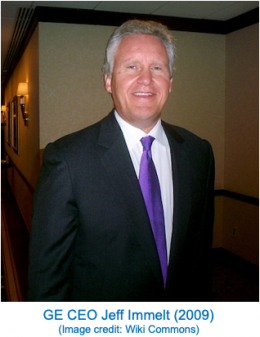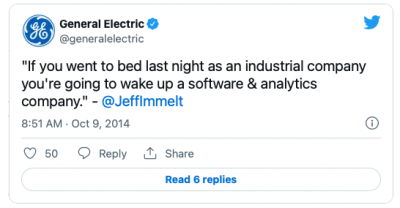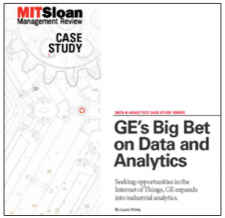
Part Three of Value-Delivery in the
Rise-and-Decline of General Electric
Illusions of Destiny Controlled & the Word’s Real Losses
By Michael J. Lanning––Copyright © 2022-23 All Rights Reserved
This is Part Three of our four-part series on GE’s great rise and eventual dramatic decline, seen through our value-delivery lens. Businesses as much as ever need strategies that deliver superior value to customers, including via major product-innovation. GE’s lengthy history offers striking lessons on this key challenge. Previous posts in this series provided an Introductory Overview, then Part One on GE’s first century (1878-1980), followed by Part Two on the Jack Welch era (1981-2010). Now, this Part Three reviews GE’s period of Digital Delusions (2011-2018). (Note from the author: special thanks to colleagues Helmut Meixner and Jim Tyrone for tremendously valuable help on this series.)
In 2011, in the wake of the global financial crisis, GE launched a “digital transformation,” a much praised initiative aiming for major new business and revenues from software. The company had presciently foreseen an explosive growth in the “Industrial Internet,” the installation and connection of digital technology with industrial equipment. In GE’s vision, this phenomenon would result in massive data about equipment-performance and would enable the company to establish a powerful software-platform as the “Operating System” for the Industrial Internet. GE therefore expected the initiative to pay off handsomely.
However, GE overestimated three factors: the potential benefit to industrial customers from applying this resulting data; the willingness of customers to share that data with GE; and the ability of GE to establish a viable software platform. As a result, this initiative produced very disappointing results. Even more important, it ignored the fundamental goal that should have been GE’s top priority after 2011: reestablishing its strategy––as prior to Jack Welch in 1981––for creating large, new, innovation-based product-businesses. Thus, the period of this transformation, 2011-2018, proved mostly one of Digital Delusions.
* * *
By 2011, GE had gone through two major strategic eras since its 1878 founding, and now needed new direction. In the first of these eras––GE’s first century, through 1980––it had created huge, profitable, electrically related product-businesses, via major product-innovations. However, after growth slowed in the 1970s, the impatient, aggressive Jack Welch and successor Jeff Immelt essentially abandoned that earlier strategy. Instead, in its second era––1981-2010––GE followed Welch’s radical, hybrid strategy, leveraging the strengths of its traditional product-businesses to dramatically expand its financial ones.
This ingenious strategy made GE the world’s most valued and admired corporation by 2000. Yet, longer-term it proved a major error. GE’s financial business could not sustain its hyper-fast growth much past 2000. Finally––riskier than the company had understood––this high-flying engine of the company’s growth largely collapsed in the 2008-2010 crisis.
In its third era––2011-2018––GE could have returned to its highly successful, first-era strategy. Instead, although downsizing its financial business, GE otherwise continued the key error of its second era––no longer creating large new, innovation-based product-businesses. GE’s star had faded somewhat, while the tech giants had begun to dominate the business-community’s imagination. GE wanted to retake leadership––so, it too would become a “digital” super-star. Welch’s GE had made a bad long-term bet on the hybrid strategy; Immelt’s GE now made another bad bet, this time, on “digital transformation.”
In this widely applauded transformation, GE formed a new business, GE Digital. It aimed to be a leading software provider, focused on reducing equipment-downtime and thus maintenance costs, and developed a major cloud-based software platform. By 2017, however, after spending close to $7 billion on this digital transformation, it was clear that GE would not reach even 10% of its $15 billion software-revenue goal. By then, only 8% of GE’s industrial customers were using its cloud-based Predix software. In 2018, when Digital was spun off, it only showed $1.2 billion in annual software revenue. More important than missing its software dreams, GE in its third era would fail to reestablish a strategy for creating large new, innovation-based product-businesses. GE’s celebrated digital transformation would ultimately prove little more than a digital delusion.
After the Crisis––An Incomplete and Misguided Strategic-Refocus
In the wake of the global financial crisis, Immelt’s team did see the need to refocus GE on its traditional––non-financial––businesses. Revenues from GEC––its financial businesses––had peaked by 2000 at about 50% of total GE. They declined in the next decade but were still over 30% of GE in 2009. Reacting to the crisis, GE exited consumer finance, and GEC dropped below 12% of GE by 2010, to dwindle further in the next few years.
As the NY Times’ Steve Lohr writes in December 2010: 
So G.E. has revamped its strategy in the wake of the financial crisis. Its heritage of industrial innovation reaches back to Thomas Edison and the incandescent light bulb, and with that legacy in mind, G.E. is going back to basics. The company, Mr. Immelt insists, must rely more on making physical products and less on financial engineering… Mr. Immelt candidly admits that G.E. was seduced by GE Capital’s financial promise––the lure of rapid-fire money-making unencumbered by the long-range planning, costs and headaches that go into producing heavy-duty material goods.
However, while GE did thus deemphasize its financial-businesses, it otherwise failed to completely refocus on its first-century strategy––creating huge new product-businesses via major innovation. While it could have grown its core, mature businesses––Electric Power, Lighting, Appliances, Jet Engines, and Medical Imaging––at GDP rate (2% for 2010-2015), GE wanted much faster growth. For that, it would have needed to enter other large markets with potential GE-synergies.
 Sure enough, GE under Welch and Immelt had abandoned or neglected several such markets, including semiconductors, computers, electronics, and electric vehicles. Aggressively entering or reentering some of these, GE’s strategic roots might have enabled it to again deliver superior value and create major new businesses. Unfortunately, GE did not try this complete strategic refocus, choosing instead to follow the route of digital transformation.
Sure enough, GE under Welch and Immelt had abandoned or neglected several such markets, including semiconductors, computers, electronics, and electric vehicles. Aggressively entering or reentering some of these, GE’s strategic roots might have enabled it to again deliver superior value and create major new businesses. Unfortunately, GE did not try this complete strategic refocus, choosing instead to follow the route of digital transformation.
After 2011, GE foresaw the rise of the Industrial Internet, central to its vision of digital transformation. Millions of powerful-but-inexpensive sensors would be connected to industrial equipment, yielding enormous data. “Advanced Analytics,” including machine-learning and artificial intelligence (AI), could mine that Big Data for insights into equipment efficiency-and-performance improvements.
 GE would, it said, become a “software and analytics company.” Starting in 2012, it had developed a cloud-based software-platform, Predix, meant to become the “operating system for the industrial internet.” By 2015, the company formed a new business, GE Digital. Hoping for major new revenues––like the earlier financial business––GE projected that it would become a “top-ten” software provider, with revenues by 2020 of $15 billion (~19% of product-business revenues). The business community and media applauded this trendy, new vision of digital transformation.
GE would, it said, become a “software and analytics company.” Starting in 2012, it had developed a cloud-based software-platform, Predix, meant to become the “operating system for the industrial internet.” By 2015, the company formed a new business, GE Digital. Hoping for major new revenues––like the earlier financial business––GE projected that it would become a “top-ten” software provider, with revenues by 2020 of $15 billion (~19% of product-business revenues). The business community and media applauded this trendy, new vision of digital transformation.
However, it was a muddled vision. GE had always supported its product businesses with a software function, but now tried to convert that support function into a separate business with its own revenues––GE Digital. This vision inevitably created confusion and conflict over the purpose of GE software applications––whether to focus primarily on supporting GE product-businesses, or on maximizing GE Digital’s software revenues.
Compounding this confusion, GE underestimated the challenges of developing all the software needed, and the need for customized––not generic––customer-solutions. Having been early to focus on the Industrial Internet, GE over-confidently underestimated the intensity of competition that would quickly emerge for its software, and already existed for the cloud-based platform. It also assumed that customers, including competitors, would share proprietary data, enabling GE’s analytics to uncover solutions But, many customers had no interest in sharing such sensitive data, nor in becoming reliant on GE software.
Foreseeing––and Betting Big On––the Industrial Internet
A 2012 GE paper predicted the onset of the Industrial Internet, which they argued would usher in a new era of innovation. This advance would be enabled in part by analytics, with their predictive algorithms. It would also be facilitated by the millions of inexpensive industrial sensors, and the connectivity provided by the Internet. In this vision, GE would play a leading role in developing and utilizing this Industrial Internet.
After Jeff Immelt announced this vision at a 2012 conference in San Francisco, the business media strongly embraced it. Soon, the Industrial Internet was also termed the Industrial Internet of Things (IIoT).  In a 2014 Fast Company article, “Behind GE’s Vision for the IIoT,” Jon Gertner looks back at that presentation:
In a 2014 Fast Company article, “Behind GE’s Vision for the IIoT,” Jon Gertner looks back at that presentation:
GE could no longer just build big machines like locomotives and jet engines and gas turbine power plants–“big iron,” … It now had to create a kind of intelligence within the machines, which would collect and parse their data. As [Immelt] saw it, the marriage of big-data analysis and industrial engineering promised a nearly unimaginable range of improvements.
GE correctly predicted that data generated by the IIoT, and analytics applied to that data, would both grow explosively. The company began investing in resources to play a leading role in the emerging IIoT. Laura Winig, in a 2016 MIT Sloan Review article, wrote that GE had “bet big” on the Industrial Internet, investing “$1 billion” adding sensors to GE machines, connecting them to the cloud and analyzing the resulting data to “improve machine productivity and reliability.” GE and others expected this digital transformation to payoff especially in one key benefit for industrial businesses––improved predictive maintenance.
Digital Transformation as Central GE Strategy
By 2016, Immelt’s team and others were referring to GE as the First Digital Industrial Company––a change they saw as a key element in digital transformation. Winig further comments on a GE advertising campaign, then recently launched:
The campaign was designed to recruit Millennials to join GE as Industrial Internet developers and remind them—using GE’s new watchwords, “The digital company. That’s also an industrial company.”—of GE’s massive digital transformation effort.
Ed Crooks, in Financial Times January 2016 discusses GE installation of systems for collecting and analyzing manufacturing data, in a growing number of its factories:
The technology is just part of a radical overhaul designed to transform the 123-year-old group [GE] into what Jeff Immelt, chief executive since September 2001, calls a “digital industrial” company. At its core is a drive to use advances in sensors, communications and data analytics to improve performance both for itself and its customers.
“It is a major change, not only in the products, but also in the way the company operates,” says Michael Porter of Harvard Business School. “This really is going to be a game-changer for GE.”
However, it is not clear in retrospect why this transformation should have been such a priority. The new digital technology could and should have been used by GE to enable the value-delivery strategies of the company’s product businesses, without transforming GE into a “Digital Industrial Company.” Nonetheless, conventional wisdom continued to insist that this digital transformation was mandatory. As the business-media and others seemed to agree––GE was ahead, and industrial businesses needed to catch up. Steve Lohr, also in 2016 in the NY Times, discussed the widespread hype for GE’s software effort, quoting another HBR professor:
“The real danger is that the data and analysis becomes worth more than the installed equipment itself,” said Karim R. Lakhani
In a 2017 Forbes article, Randy Bean and Thomas Davenport even issue a warning––GE had achieved its digital transformation:
 Mainstream legacy businesses should take note. In a matter of only a few years, GE has migrated from being an industrial and consumer products and financial services firm to a “digital industrial” company with a strong focus on the “Industrial Internet” ….[achieved by] leveraging AI and machine learning fueled by the power of Big Data.
Mainstream legacy businesses should take note. In a matter of only a few years, GE has migrated from being an industrial and consumer products and financial services firm to a “digital industrial” company with a strong focus on the “Industrial Internet” ….[achieved by] leveraging AI and machine learning fueled by the power of Big Data.
Also in 2017, HBR published an interview with Immelt, How I Remade GE. It implied that GE’s digital initiative had achieved another great GE triumph, thanks to the decision by Immelt and the company to go “All In.” As Jeff explains:
We’ve approached digital very differently from the way other industrial and consumer products companies have. Most say, “We’ll take an equity stake in a digital start-up, and that is our strategy.” To my mind, that’s dabbling. I wanted to get enough scale fast enough to make it meaningful.
Thus, GE had earlier, enthusiastically launched Digital and the Predix platform business. However, by late 2017, it was dawning on observers that GE’s digital transformation might be ahead of others but lacked clear evidence of building a viable software business. Partly for this reason, Immelt would be forced out of GE later that year.
Lohr in the NY Times, later that year, writes that:
G.E. not only weathered the financial crisis but also made large investments. A crucial initiative has been to transform G.E. into a “digital-industrial” company, adding software and data analysis to its heavy equipment. But the digital buildup has been costly. G.E. will have invested $6.6 billion, from 2011 through the end of this year, with most of the spending in the last two years… Such investments, however, had a trade-off, as they sacrificed near-term profit for a hoped-for future payoff.
By 2018, the business media began to note the apparently wide-spread failure of digital transformations. Many consultants and academics had become devoted to the view that such transformation was mandatory, so many argued (and still do today) that companies needed to try harder. However, the obstacles seemed to be formidable, as numerous companies fell short. In 2018, Davenport and George Westerman would write in HBR:
In 2011, GE embarked upon an ambitious attempt to digitally transform its product and service offerings. The company created impressive digital capabilities, labeling itself a “digital industrial” company, embedding sensors into many products, building a huge new software platform for the Internet of Things, and transforming business models for its industrial offerings. The company received much acclaim for its transformation in the press (including some from us). However, investors didn’t seem to acknowledge its transformation. The company’s stock price has languished for years, and CEO Jeff Immelt…recently departed the company under pressure from activist investors.
Most fundamentally, GE’s Digital venture and its pursuit of digital transformation did not help the company redirect its strategy toward creating large new, innovation-based product-businesses. More specifically, GE in its third strategic era––2011-2018––made three bad bets in particular, focused on overestimations of: the value of reduced equipment-downtime; the willingness of customers to share proprietary information; and GE’s ability to provide a universal operating system for the industrial internet.
GE’s Bad Bet on the Inherent Universal Value of Reduced Downtime
Industrial companies had long worked to improve predictive maintenance (PM)––predicting and avoiding equipment-failure, thus reducing unplanned downtime and maintenance costs. After about 2010, improved PM was enabled, in principle, by the widespread advances in quantities of Big Data collected, and in the power of analytics. Savings in GE’s own manufacturing seemed possible, but potential customer-value seemed especially exciting. As Immelt explains in his 2014 Fast Company interview:
Being able to walk into the offices of an airline or a freight CEO and tell him that data might ensure that GE jet engines or locomotives would have no unplanned downtime could change the way Immelt’s company does business. GE products could almost sell themselves––or, if his competitors had the capability to do this first, stop selling at all.
Given the history of GE’s product businesses since the 1980s, it was a natural extension of that evolution for Immelt’s GE to now focus heavily on PM. Under Welch, the company had reduced its commitment to major advances in the benefits delivered by its products, shifting its relative focus to service benefits. Not surprisingly, GE now saw improved PM as a major prize of digital transformation. Winig explains the value of PM:
While many software companies like SAP, Oracle, and Microsoft have traditionally been focused on providing technology for the back office, GE is leading the development of a new breed of operational technology (OT) that literally sits on top of industrial machinery. Long known as the technology that controls and monitors machines, OT now goes beyond these functions by connecting machines via the cloud and using data analytics to help predict breakdowns and assess the machines’ overall health.
Therefore, improving PM of a customer’s GE equipment, via Big Data and analytics, made sense––but only if the obstacles and cost of doing so were outweighed by the benefits of reduced unplanned-downtime. This result turned out to be disappointingly problematic.
First, reducing an industrial-customer’s unplanned downtime is highly valuable only in cases where that downtime would be crucially disruptive and expensive for that customer. Such a result can occur, for example, when that unplanned downtime of some equipment shuts down an entire operation for a significant time period. However, when the customer’s operation has ready access to replacement or alternative equipment, the total costs of the unplanned downtime maybe fairly minor. In such a case, the cost of achieving highly accurate PM may not be justified.
GE’s Bad Bet That Industrial Customers Would Willingly Share Proprietary Info
On the other hand, in some cases, eliminating or greatly reducing unplanned downtime––such as via great PM––has great value for the customer. However, this great PM depends on access to extensive customer-data that can be used to analyze the customer’s equipment and predict likely breakdowns. For such data, GE realized that it needed to include customer data from much more than its own equipment. As Winig continued:
GE had spent years developing analytic applications to improve the productivity and reliability of its own equipment…GE’s strategy is to deploy these solutions and then expand to include non-GE plant equipment as part of the solution. GE wants to go beyond helping its customers manage the performance of individual GE machines to managing the data on all of the machines in a customer’s entire operation. Customers are asking GE to analyze non-GE equipment because those machines comprise about 80% of the equipment in their facilities. They’re saying, ‘It does me no good if my $10 million gas turbine runs at 98% reliability if I have a valve that fails and shuts my entire plant down.’
Therefore, to conduct the analysis needed to improve a customer’s PM, GE needed access to data from all a customer’s equipment––including non-GE equipment, even competitors’ machines. This requirement would pose a bigger conflict with customers’ priorities than GE first anticipated. As Winig’s Sloan Review colleague Sam Ransbotham adds:
Unsurprisingly, GE has struggled with this step, as everyone loves the idea of benefiting from everyone else’s data, but is far less excited about sharing their own—a tragedy of the commons. The potential is there, but incentives are not well aligned.
GE never made much progress convincing customers to disregard this conflict. Moreover, collecting and analyzing the data needed to improve PM proved more complex than GE expected.  Retrospectively in 2019, Brian Bunz in IoT World Today commented that we can still expect additional progress in PM, but that applying machine learning, including for PM, is often dauntingly complex. He cited a Bain & Co. study among 600 high-tech executives, finding that IIoT and PM in particular are often complex to implement, frustrating the effort to capture valuable insights.
Retrospectively in 2019, Brian Bunz in IoT World Today commented that we can still expect additional progress in PM, but that applying machine learning, including for PM, is often dauntingly complex. He cited a Bain & Co. study among 600 high-tech executives, finding that IIoT and PM in particular are often complex to implement, frustrating the effort to capture valuable insights.
GE’s Bad Bet on Providing the Operating System for the Industrial Internet
In an important aspect of its digital transformation, GE assumed it needed to build a new software platform that could handle massive data sets, enabling the connection and analysis of that data. Thus, GE thought, such a platform could allow the key, powerful analyses that would improve equipment efficiency and performance. Thus, such a platform, as envisioned by GE, could become the “operating system of the Industrial Internet.” The company therefore began to build such a platform, which it named Predix.
However, playing such a central role for most or all industrial companies––including many competitors to GE––was not a realistic goal. And more importantly, playing this “operating system” role was not necessary. Many observers have speculated on why Predix failed, asking in effect what the Predix value proposition was, and why it wasn’t well enough delivered. More fundamentally, however, Predix and such an operating system did not have a reason for being and thus no superior value proposition it could deliver.
GE, nonetheless, concluded that it should and could gain a dominant position in cloud computing, as part of becoming the operating system of the Industrial Internet, and so it launched Predix in 2013. For The Street in June 2015, James Passeri writes that:
 General Electric is betting its cloud-based Predix platform will do for factories what Apple’s iOS did for cell phones…GE has rolled out 40 apps this year for industrial companies using its rapidly growing industrial software platform, which combines device sensors with data analytics to optimize performance and extend equipment life…
General Electric is betting its cloud-based Predix platform will do for factories what Apple’s iOS did for cell phones…GE has rolled out 40 apps this year for industrial companies using its rapidly growing industrial software platform, which combines device sensors with data analytics to optimize performance and extend equipment life…
However, digital giants were already providing and investing heavily in cloud-based services. Amazon Web Services (AWS) launched in 2006, Microsoft’s Azure in 2008, followed by Google and later Siemens, IBM, and others. Yet, GE seemed to imagine that since it focused on industrial––not consumer––data, it need not compete with established cloud players. Passeri quotes Bill Ruh, GE’s VP of global software, on the supposedly unique advantages of Predix:
“In the future, it’s going to be about taking analytics and making that part of our product line like a turbine, an engine or an MRI” machine… “This cloud is purpose-built for the industrial world as other clouds are built for the consumer world,” he said.
In 2016, GE and some observers believed that Predix put GE in position to lead and even control most or all IIoT software and its use. Winig, in MIT Sloan Review, comments that:
GE executives believe the company can follow in Google’s footsteps and become the entrenched established platform player for the Industrial Internet— and in less than the 10 years it took Google.
GE may have seen Microsoft as an even more relevant model for GE’s possible domination of IIoT software. Immelt in his 2017 retrospective interview in HBR continues:
When we started the digital industrial move, I had no thought of creating the Predix platform business. None. We had started this analytical apps organization. Three years later some of the people we had hired from Microsoft said, “Look, if you’re going to build this application world, that’s OK. But if you want to really get the value, you’ve got to do what Microsoft did with Windows and be the platform for the industrial internet.” That meant we would have to create our own ecosystem; open up what we were doing to partners, developers, customers, and noncustomers; and let the industry embrace it.
So we pivoted. Again we went all the way. We not only increased our investment in digital by an order of magnitude—a billion dollars—but also told all our businesses, “We’re going to sunset all our other analytics-based software initiatives and put everybody on Predix, and we’re going to have an open system so that your competitors can use it just like you can.”
However, Predix never became a widely accepted product, so it lacked the marketplace leverage of Microsoft’s Windows. Moreover, Predix’s success required access to industrial customers’ proprietary data, the same obstacle that generally inhibited GE’s success with Predictive Maintenance, as discussed earlier. In 2016, The Economist writes:
 Whereas individual consumers are by and large willing to give up personal information to one platform, such as Google or Facebook, most companies try to avoid such lock-in. Whether they are makers of machine tools or operators of a factory, they jealously guard their data because they know how much they are worth.
Whereas individual consumers are by and large willing to give up personal information to one platform, such as Google or Facebook, most companies try to avoid such lock-in. Whether they are makers of machine tools or operators of a factory, they jealously guard their data because they know how much they are worth.
By 2017, it was becoming clear that the triumph of Predix would be deferred, partly reflecting this conflict between the vision GE wanted and some of the key priorities of customers. In June of 2017, Ed Crooks in Financial Times writes that:
Last year there were 2.4bn connected devices being used by businesses, and this year there will be 3.1bn, according to Gartner, the research group. By 2020, it expects that number to have more than doubled to 7.6bn. …[However] the shiny digital future is arriving later than some had hoped. The potential is real, says McKinsey senior partner Venkat Atluri, but industrial companies have been slow to exploit it for a variety of reasons. They may need to change their organisations radically to benefit from the new technologies. Another obstacle is that there are so many different products and services available that industrial standards have not yet emerged.
Working with expensive and potentially hazardous machinery, industrial businesses are cautious about entrusting critical decisions to outsiders. “Customers are risk-averse, because they have to be,” says Guido Jouret, chief digital officer of ABB. “If you do something wrong, you can hurt people.”
Potential customers are also very cautious about control of the data that reveal the inner workings of their operations.
Eventually, it sank into GE that competing with the established cloud providers was not realistic, and that establishing a dominant platform was in any case pointless. Alwyn Scott in Reuters wrote later in 2017 regarding GE missteps with Predix:
 Engineers initially advised building data centers that would house the “Predix Cloud.” But [after Amazon Microsoft spent billions] on data centers for their cloud services, AWS and Azure, GE changed course…abandoned its go-it-alone cloud strategy a year ago. “That is not an investment we can compete with,” Ruh said.
Engineers initially advised building data centers that would house the “Predix Cloud.” But [after Amazon Microsoft spent billions] on data centers for their cloud services, AWS and Azure, GE changed course…abandoned its go-it-alone cloud strategy a year ago. “That is not an investment we can compete with,” Ruh said.
It now relies on AWS & expects to be using Azure by late October. As GE pivoted away from building data centers…focused on applications, which executives now saw as more useful for winning business and more profitable than the platform alone. “That is probably the biggest lesson we’re learned,” Ruh said. [Predix] also faced legacy challenges in adapting to Predix software. GE has many algorithms for monitoring its machines, but they mostly were written in different coding languages and reside on other systems in GE businesses. This makes transferring them to Predix more time consuming.
An additional complexity facing GE Digital was that the company’s businesses were of course varied, requiring a range of solutions and value propositions. Related to this issue, tech writer and follower of the IIoT, Stacy Higginbotham, observed that GE’s IIoT effort cannot work with the same solution for every customer (or segment). She writes in late 2017 that:
Since launching its industrial IoT effort five years ago, GE has spent billions selling the internet of things to investors, analysts and customers. GE is learning that the industrial IoT isn’t a problem that can be tackled as a horizontal platform play. Five years after it began, GE is learning lessons that almost every industrial IoT platform I’ve spoken with is also learning. The industrial IoT doesn’t scale horizontally. Nor can a platform provider compete at every layer. What has happened is that at the computing [layer,] larger cloud providers like Microsoft and Amazon are winning.
So when it comes to the industrial IoT, the opportunity is big. It’s just taking a while to figure out how to attack the market. Step one is realizing that it’s silly to take on the big cloud and connectivity providers. Step two is quitting the platform dreams and focusing on a specific area of expertise.
In a similar, common-sensical observation on Medium, product-management and innovation writer Ravi Kumar writesthat GE’s IIoT platform failed because GE tried:
Supporting too many vertical markets: It’s difficult to build a software platform that works across many verticals. GE tried to be everything to everyone and built an all purpose platform for the wider industrial world, which was a diffused strategy.
In retrospect, it would appear that GE failed to look at its venture into Predix in some fundamental ways; ways that a value delivery assessment could very well have identified. There seemed to be an assumption that customers would benefit from Predix rather than a rigorous description of those benefits and the possibly superior value proposition of Predix, and trade-offs that customers would need to make.
However, at least one company, widely applauded, recognized the real potential of the new digital technology. It did so––in contrast to GE––by using IIoT and analytics to enable the strategy of its existing business, not to build a new, separate “digital business.”
Caterpillar––Unlike GE––Used IIoT & Analytics to Enable Its Strategy
 Prior to 2012, Caterpillar––the large manufacturer of construction and mining equipment––had long delivered a superior value proposition. Cat’s business model had produced lower life-time cost for customers, via superior equipment-uptime. As Geoff Colvin explains in Fortune in 2011:
Prior to 2012, Caterpillar––the large manufacturer of construction and mining equipment––had long delivered a superior value proposition. Cat’s business model had produced lower life-time cost for customers, via superior equipment-uptime. As Geoff Colvin explains in Fortune in 2011:
 The model’s goal is simple: Ensure that customers make more money using Cat equipment than using competitors’ equipment. Though Cat equipment generally costs more than anyone else’s, the model requires it to be the least expensive over its lifetime. For customers, maintenance and uptime are critical.
The model’s goal is simple: Ensure that customers make more money using Cat equipment than using competitors’ equipment. Though Cat equipment generally costs more than anyone else’s, the model requires it to be the least expensive over its lifetime. For customers, maintenance and uptime are critical.
Kenny Rush, vice president of Sellersburg Stone in Louisville, says that’s why he’s such a fan of the Caterpillar 992 loader his firm uses in a quarry. “We’ve run that machine since 1998, and it’s had 98% to 99% availability,” he says. “It cost $1.5 million. But we ran it 22,000 hours, which is about 10 years, before replacing any major components.” Dealers are key to those economics. A machine that breaks down can halt an entire job, and getting back under way in two hours rather than 48 hours means big money. Large, successful dealers that carry lots of parts, maintain skilled technicians, and move fast are thus a major selling point, and Cat’s dealer network is the undisputed best in the business.
This one clear value proposition––superior equipment-uptime––applied to essentially all of Cat’s customers. Now, after 2012, Cat recognized that improving PM––via analytics applied to massive IIoT-data––would perfectly build on and strengthen Cat’s earlier, uptime-focused strategy. Cat should not be understood as having succeeded in executing the digital transformation strategy that GE had tried but failed to execute. Rather, Cat pursued a strategy focused on delivering its established value proposition of superior uptime, but using the new digital technology to help.
At this time, GE also tried to use the digital technology, but primarily to achieve “digital transformation,” chasing a vague notion of digital strategy. Cat instead integrated the technology into its existing business, enabling rather than replacing its strategy that had long focused on making customers’ more successful.
 In doing so, Cat––unlike GE––did not try to create the software it needed but more realistically partnered with an analytics start-up firm, Uptake. As Lindsay Whipp writes in Financial Times, in August 2016:
In doing so, Cat––unlike GE––did not try to create the software it needed but more realistically partnered with an analytics start-up firm, Uptake. As Lindsay Whipp writes in Financial Times, in August 2016:
 Uptake, which was reported last year to have a $1bn valuation and in which Caterpillar has an undisclosed stake, uses its proprietary software to trawl the immense amount of data collected from Caterpillar’s clients to predict when a machine needs repairing, preventing accidents and extended downtime, and saving money.
Uptake, which was reported last year to have a $1bn valuation and in which Caterpillar has an undisclosed stake, uses its proprietary software to trawl the immense amount of data collected from Caterpillar’s clients to predict when a machine needs repairing, preventing accidents and extended downtime, and saving money.
Caterpillar conducted a study of a large mining company’s malfunctioning machine, which had resulted in 900 hours of downtime and $650,000 in repairs. If the technology from the two companies’ project had been applied, the machine’s downtime would have been less than 24 hours and the repairs only $12,000.
Additional articles in 2017, in Forbes, WSJ, and Business Insider emphasized Cat’s improvements in PM via analytics applied to IIoT-data. GE continued generating hype around its software promises of IIoT applications and the utility of Predix––the “operating system for the industrial internet.” More modestly, but delivering more substance, Cat only focused on delivering its specific value proposition for its users. As Tom Bucklar, Cat’s Director of IoT, explains in a 2018 article in Caterpillar News:
When we start to talk about our digital strategy, we really look at digital as an enabler. At the end of the day, we’re not trying to build a digital business. We’re trying to make our customers more profitable.
 However, for many industrial businesses––including most of GE’s businesses during this 2011-2018 era––the value of uptime for its equipment varies. Unplanned downtime always has some cost but avoiding it––such as by analytics––does not always justify major investments. In many cases, an operation can affordably work its way around unplanned downtime on a piece of equipment. As Kim Nash, quoting Cat’s Bucklar, explains in WSJ, some of Cat’s most complex machines may be a customer’s most crucial ones. For those, downtime is unaffordable, but a simpler machine could be easily replaced. In that case, there will not be “as much customer value in that prediction.”
However, for many industrial businesses––including most of GE’s businesses during this 2011-2018 era––the value of uptime for its equipment varies. Unplanned downtime always has some cost but avoiding it––such as by analytics––does not always justify major investments. In many cases, an operation can affordably work its way around unplanned downtime on a piece of equipment. As Kim Nash, quoting Cat’s Bucklar, explains in WSJ, some of Cat’s most complex machines may be a customer’s most crucial ones. For those, downtime is unaffordable, but a simpler machine could be easily replaced. In that case, there will not be “as much customer value in that prediction.”
Thus, GE could not have simply applied Cat’s specific, superior-uptime value proposition to GE’s businesses, each of which needed to deliver their own specific value proposition. Cat saw it could enable its specific, uptime-focused strategy, via Big Data and analytics. Confused, GE equated its strategy with using data and analytics, and pursuing digital transformation, applying the same, generic digital strategy for all customers.
Caterpillar did not need to develop a software platform––it simply needed to deliver its clear, superior value proposition. Likewise, GE did not need to make the Predix platform work–––GE needed to choose a clear value proposition in each major business and then use the digital technology to help deliver each of those propositions successfully.
GE failed in two key ways. First, it failed to focus on specific strategies to profitably deliver superior value in its various businesses. And, secondly, it failed to then use digital technology and capabilities to enable those value-delivery strategies. This mentality, prioritizing the enabling of their strategy rather than prioritizing digital assets and skills, characterizes the approach that Caterpillar––in contrast to GE––so successfully followed. Some observers would argue today that Cat succeeded in a “digital transformation,” but it did not really transform––it simply focused on using analytics to better execute its clear, customer-focused, uptime strategy. Thus, GE failed by focusing too much on its digital transformation, working to become the first digital industrial company, and not enough to develop its value-delivery strategies.
Bitter End to GE’s Digital Delusions
Many observers, after Immelt had been forced out in 2017, continued to see GE Digital and the company’s attempted digital transformation as good ideas, executed badly. Probably the whole initiative could have been pursued more effectively, but the main problem with this third GE strategic era, as with GE’s second era––1981-2010––was the fundamental flaw in the company’s strategy. It wasn’t totally wrongheaded to pursue the development and use of the IIoT and analytics. It was wrong, however, to put this pursuit ahead of restoring GE’s historically successful strategy of creating large new, innovation-based product businesses.
However, the modest fiasco of the digital delusion was not the only major strategic error by Immelt and team after the financial crisis. The company would also fail to rethink its key energy-related strategies. Again chasing after the formulae that had worked in the past, GE’s blunders in this area would prove terminal for Immelt, and leave the company exposed to a final, predictable but misguided restructuring. We tell this final piece in the story of GE’s rise and decline in Part Four, Energy Misfire (2001-2019).














